Analysis of Management Accounting Systems: Morrison Case Study
VerifiedAdded on 2020/10/23
|18
|6452
|124
Report
AI Summary
This report provides a comprehensive analysis of management accounting within an organization, focusing on the case study of Morrison. It begins with an executive summary highlighting the importance, benefits, and various types of management accounting systems. The report then delves into the specifics of management accounting systems, including cost accounting, budgeting, transfer pricing, and inventory management. It explores the differences between management and financial accounting. The report includes the preparation of income statements using both marginal and absorption costing. The report also examines the use of planning tools for budgetary control, evaluating their advantages and disadvantages. Furthermore, the report assesses how organizations adapt to management accounting systems and uses them to address financial problems and achieve sustainable success. Finally, the report concludes with recommendations based on the analysis.
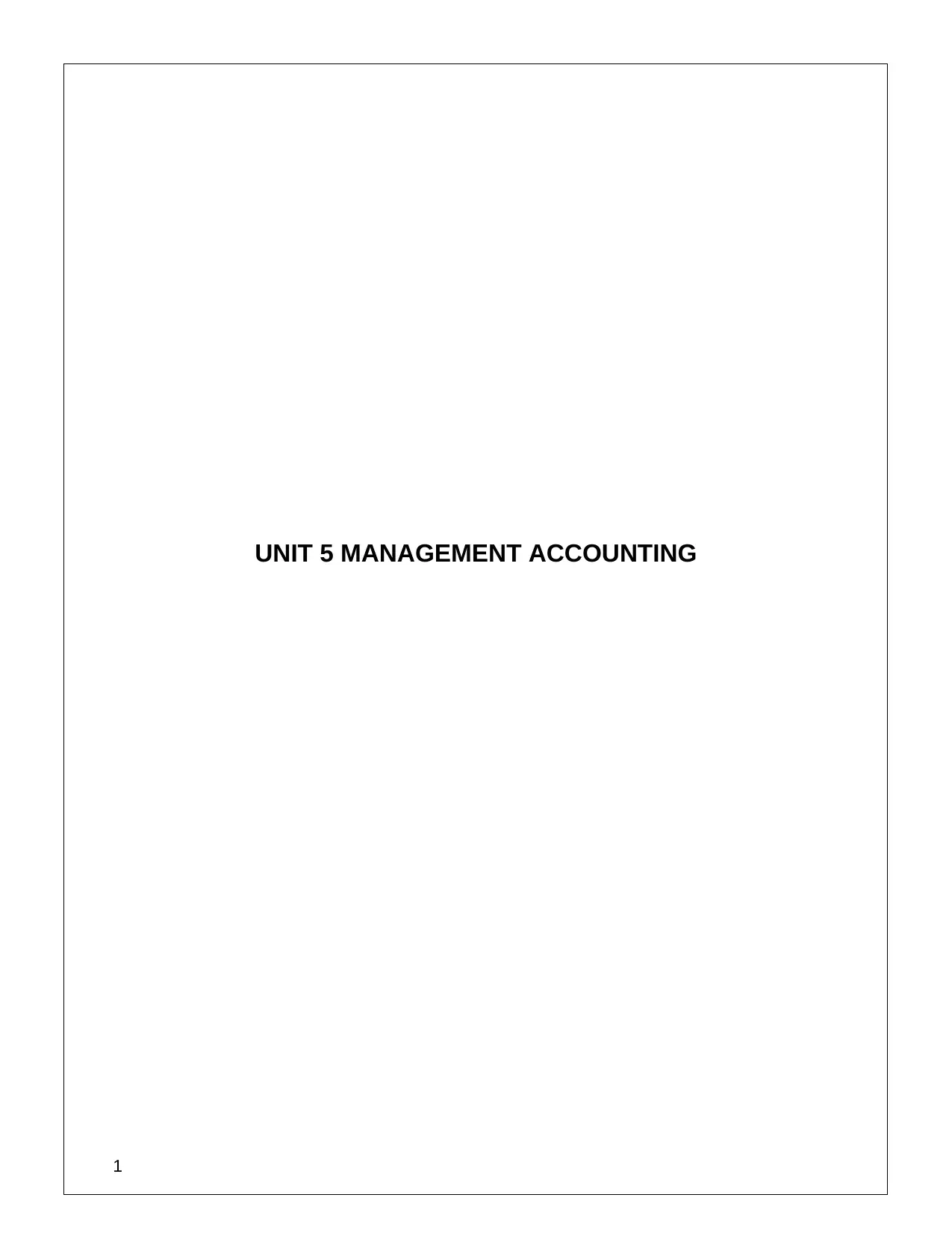
UNIT 5 MANAGEMENT ACCOUNTING
1
1
Paraphrase This Document
Need a fresh take? Get an instant paraphrase of this document with our AI Paraphraser
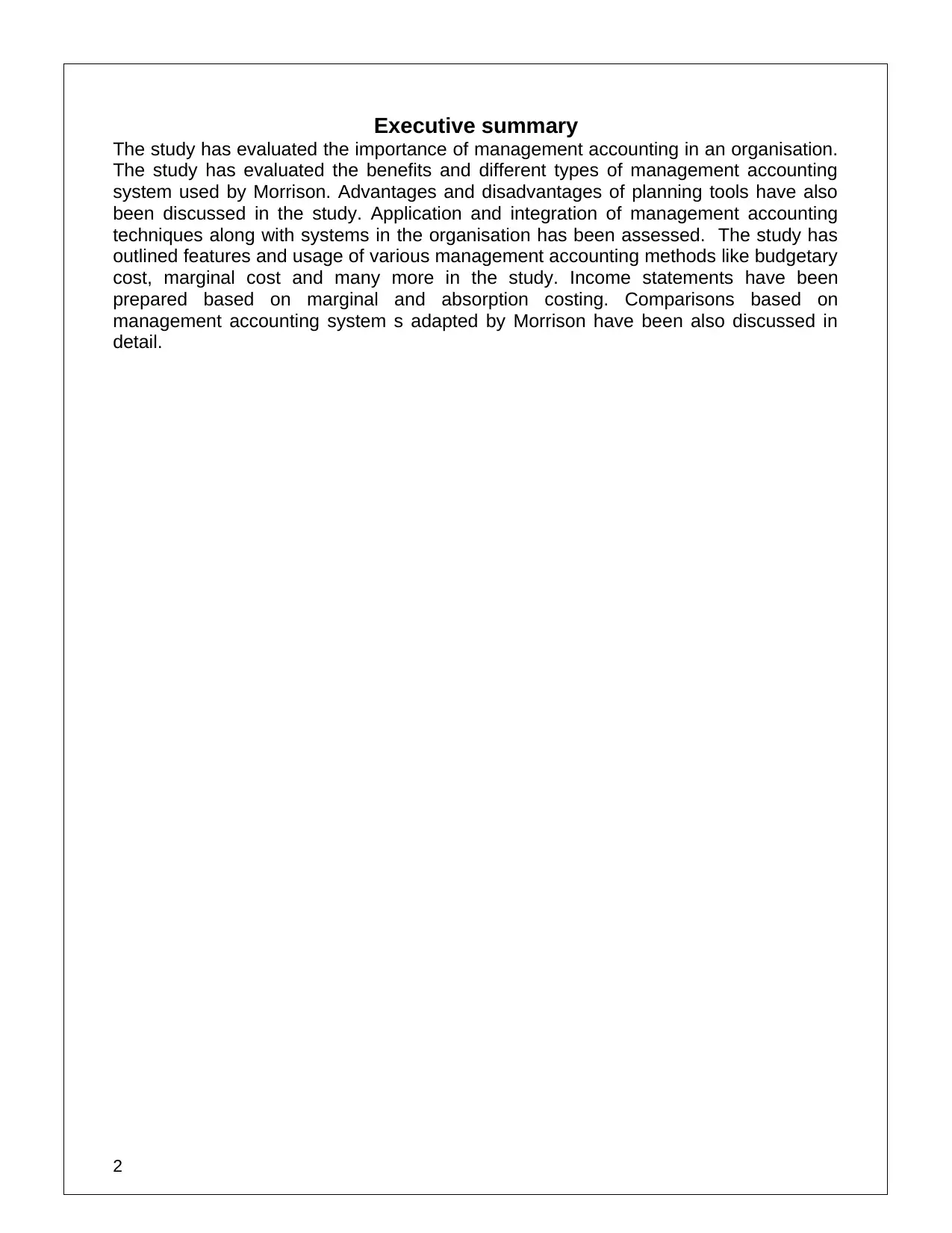
Executive summary
The study has evaluated the importance of management accounting in an organisation.
The study has evaluated the benefits and different types of management accounting
system used by Morrison. Advantages and disadvantages of planning tools have also
been discussed in the study. Application and integration of management accounting
techniques along with systems in the organisation has been assessed. The study has
outlined features and usage of various management accounting methods like budgetary
cost, marginal cost and many more in the study. Income statements have been
prepared based on marginal and absorption costing. Comparisons based on
management accounting system s adapted by Morrison have been also discussed in
detail.
2
The study has evaluated the importance of management accounting in an organisation.
The study has evaluated the benefits and different types of management accounting
system used by Morrison. Advantages and disadvantages of planning tools have also
been discussed in the study. Application and integration of management accounting
techniques along with systems in the organisation has been assessed. The study has
outlined features and usage of various management accounting methods like budgetary
cost, marginal cost and many more in the study. Income statements have been
prepared based on marginal and absorption costing. Comparisons based on
management accounting system s adapted by Morrison have been also discussed in
detail.
2
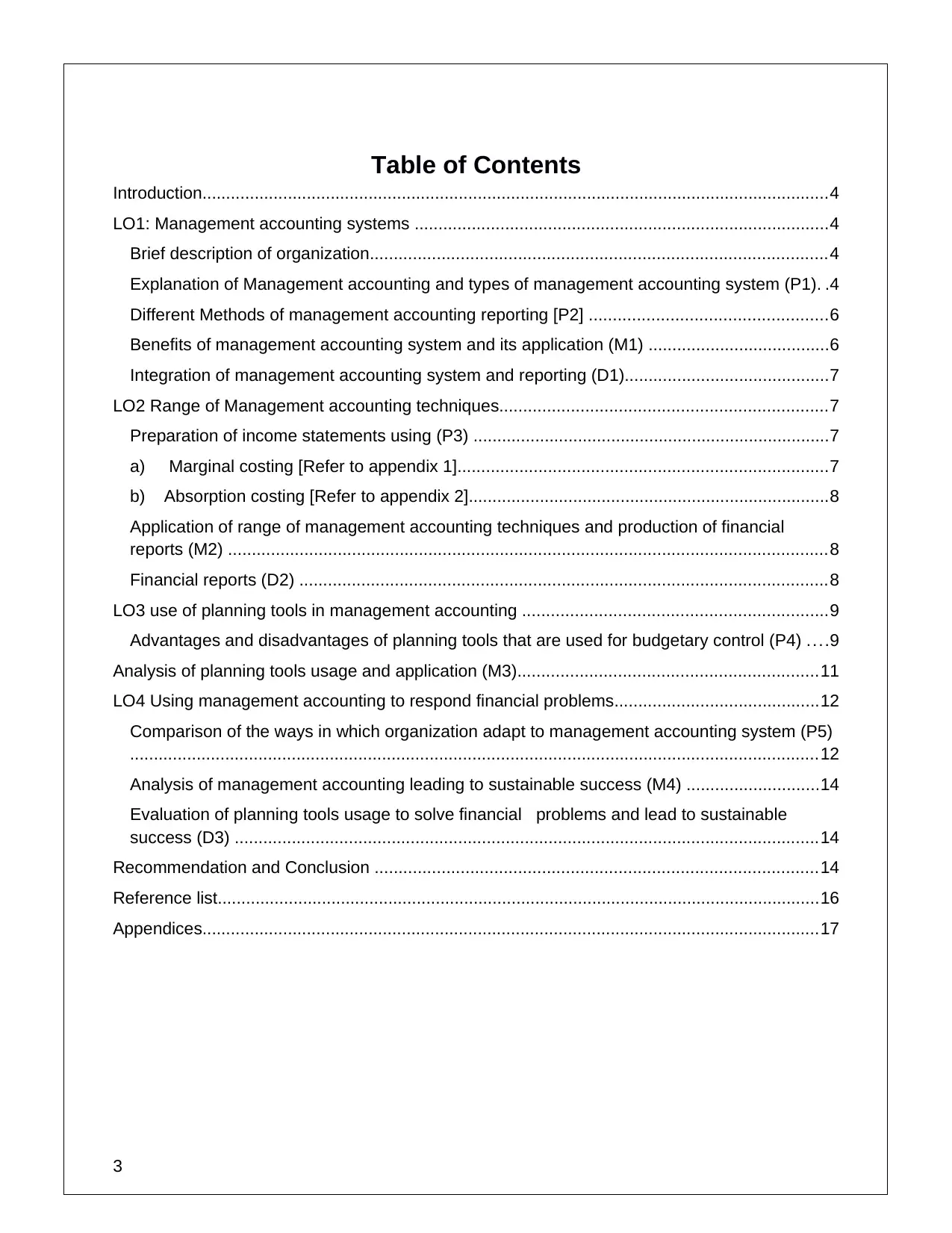
Table of Contents
Introduction....................................................................................................................................4
LO1: Management accounting systems .......................................................................................4
Brief description of organization................................................................................................4
Explanation of Management accounting and types of management accounting system (P1). .4
Different Methods of management accounting reporting [P2] ..................................................6
Benefits of management accounting system and its application (M1) ......................................6
Integration of management accounting system and reporting (D1)...........................................7
LO2 Range of Management accounting techniques.....................................................................7
Preparation of income statements using (P3) ...........................................................................7
a) Marginal costing [Refer to appendix 1]..............................................................................7
b) Absorption costing [Refer to appendix 2]............................................................................8
Application of range of management accounting techniques and production of financial
reports (M2) ..............................................................................................................................8
Financial reports (D2) ...............................................................................................................8
LO3 use of planning tools in management accounting ................................................................9
Advantages and disadvantages of planning tools that are used for budgetary control (P4) ....9
Analysis of planning tools usage and application (M3)...............................................................11
LO4 Using management accounting to respond financial problems...........................................12
Comparison of the ways in which organization adapt to management accounting system (P5)
.................................................................................................................................................12
Analysis of management accounting leading to sustainable success (M4) ............................14
Evaluation of planning tools usage to solve financial problems and lead to sustainable
success (D3) ...........................................................................................................................14
Recommendation and Conclusion .............................................................................................14
Reference list...............................................................................................................................16
Appendices..................................................................................................................................17
3
Introduction....................................................................................................................................4
LO1: Management accounting systems .......................................................................................4
Brief description of organization................................................................................................4
Explanation of Management accounting and types of management accounting system (P1). .4
Different Methods of management accounting reporting [P2] ..................................................6
Benefits of management accounting system and its application (M1) ......................................6
Integration of management accounting system and reporting (D1)...........................................7
LO2 Range of Management accounting techniques.....................................................................7
Preparation of income statements using (P3) ...........................................................................7
a) Marginal costing [Refer to appendix 1]..............................................................................7
b) Absorption costing [Refer to appendix 2]............................................................................8
Application of range of management accounting techniques and production of financial
reports (M2) ..............................................................................................................................8
Financial reports (D2) ...............................................................................................................8
LO3 use of planning tools in management accounting ................................................................9
Advantages and disadvantages of planning tools that are used for budgetary control (P4) ....9
Analysis of planning tools usage and application (M3)...............................................................11
LO4 Using management accounting to respond financial problems...........................................12
Comparison of the ways in which organization adapt to management accounting system (P5)
.................................................................................................................................................12
Analysis of management accounting leading to sustainable success (M4) ............................14
Evaluation of planning tools usage to solve financial problems and lead to sustainable
success (D3) ...........................................................................................................................14
Recommendation and Conclusion .............................................................................................14
Reference list...............................................................................................................................16
Appendices..................................................................................................................................17
3
⊘ This is a preview!⊘
Do you want full access?
Subscribe today to unlock all pages.

Trusted by 1+ million students worldwide
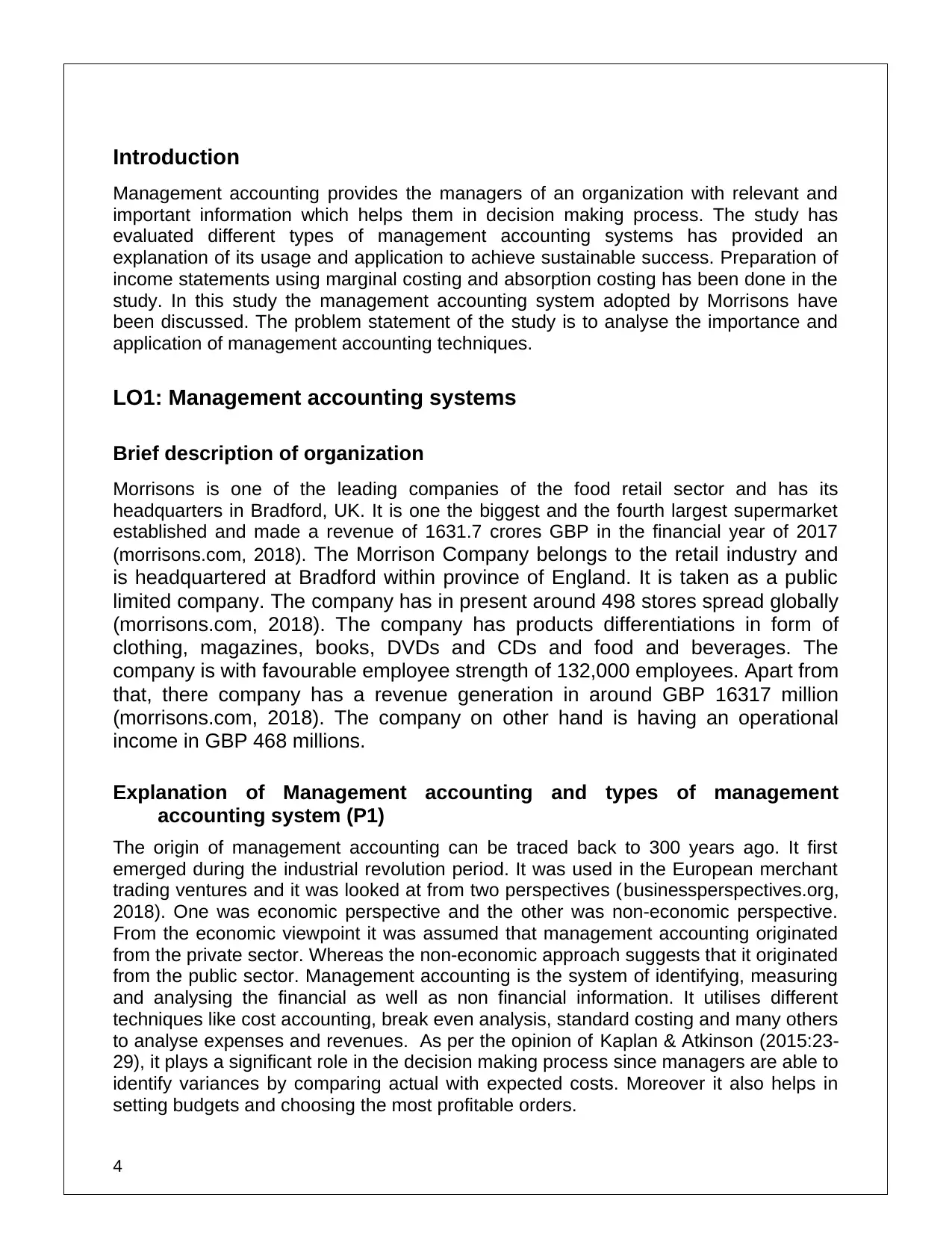
Introduction
Management accounting provides the managers of an organization with relevant and
important information which helps them in decision making process. The study has
evaluated different types of management accounting systems has provided an
explanation of its usage and application to achieve sustainable success. Preparation of
income statements using marginal costing and absorption costing has been done in the
study. In this study the management accounting system adopted by Morrisons have
been discussed. The problem statement of the study is to analyse the importance and
application of management accounting techniques.
LO1: Management accounting systems
Brief description of organization
Morrisons is one of the leading companies of the food retail sector and has its
headquarters in Bradford, UK. It is one the biggest and the fourth largest supermarket
established and made a revenue of 1631.7 crores GBP in the financial year of 2017
(morrisons.com, 2018). The Morrison Company belongs to the retail industry and
is headquartered at Bradford within province of England. It is taken as a public
limited company. The company has in present around 498 stores spread globally
(morrisons.com, 2018). The company has products differentiations in form of
clothing, magazines, books, DVDs and CDs and food and beverages. The
company is with favourable employee strength of 132,000 employees. Apart from
that, there company has a revenue generation in around GBP 16317 million
(morrisons.com, 2018). The company on other hand is having an operational
income in GBP 468 millions.
Explanation of Management accounting and types of management
accounting system (P1)
The origin of management accounting can be traced back to 300 years ago. It first
emerged during the industrial revolution period. It was used in the European merchant
trading ventures and it was looked at from two perspectives (businessperspectives.org,
2018). One was economic perspective and the other was non-economic perspective.
From the economic viewpoint it was assumed that management accounting originated
from the private sector. Whereas the non-economic approach suggests that it originated
from the public sector. Management accounting is the system of identifying, measuring
and analysing the financial as well as non financial information. It utilises different
techniques like cost accounting, break even analysis, standard costing and many others
to analyse expenses and revenues. As per the opinion of Kaplan & Atkinson (2015:23-
29), it plays a significant role in the decision making process since managers are able to
identify variances by comparing actual with expected costs. Moreover it also helps in
setting budgets and choosing the most profitable orders.
4
Management accounting provides the managers of an organization with relevant and
important information which helps them in decision making process. The study has
evaluated different types of management accounting systems has provided an
explanation of its usage and application to achieve sustainable success. Preparation of
income statements using marginal costing and absorption costing has been done in the
study. In this study the management accounting system adopted by Morrisons have
been discussed. The problem statement of the study is to analyse the importance and
application of management accounting techniques.
LO1: Management accounting systems
Brief description of organization
Morrisons is one of the leading companies of the food retail sector and has its
headquarters in Bradford, UK. It is one the biggest and the fourth largest supermarket
established and made a revenue of 1631.7 crores GBP in the financial year of 2017
(morrisons.com, 2018). The Morrison Company belongs to the retail industry and
is headquartered at Bradford within province of England. It is taken as a public
limited company. The company has in present around 498 stores spread globally
(morrisons.com, 2018). The company has products differentiations in form of
clothing, magazines, books, DVDs and CDs and food and beverages. The
company is with favourable employee strength of 132,000 employees. Apart from
that, there company has a revenue generation in around GBP 16317 million
(morrisons.com, 2018). The company on other hand is having an operational
income in GBP 468 millions.
Explanation of Management accounting and types of management
accounting system (P1)
The origin of management accounting can be traced back to 300 years ago. It first
emerged during the industrial revolution period. It was used in the European merchant
trading ventures and it was looked at from two perspectives (businessperspectives.org,
2018). One was economic perspective and the other was non-economic perspective.
From the economic viewpoint it was assumed that management accounting originated
from the private sector. Whereas the non-economic approach suggests that it originated
from the public sector. Management accounting is the system of identifying, measuring
and analysing the financial as well as non financial information. It utilises different
techniques like cost accounting, break even analysis, standard costing and many others
to analyse expenses and revenues. As per the opinion of Kaplan & Atkinson (2015:23-
29), it plays a significant role in the decision making process since managers are able to
identify variances by comparing actual with expected costs. Moreover it also helps in
setting budgets and choosing the most profitable orders.
4
Paraphrase This Document
Need a fresh take? Get an instant paraphrase of this document with our AI Paraphraser
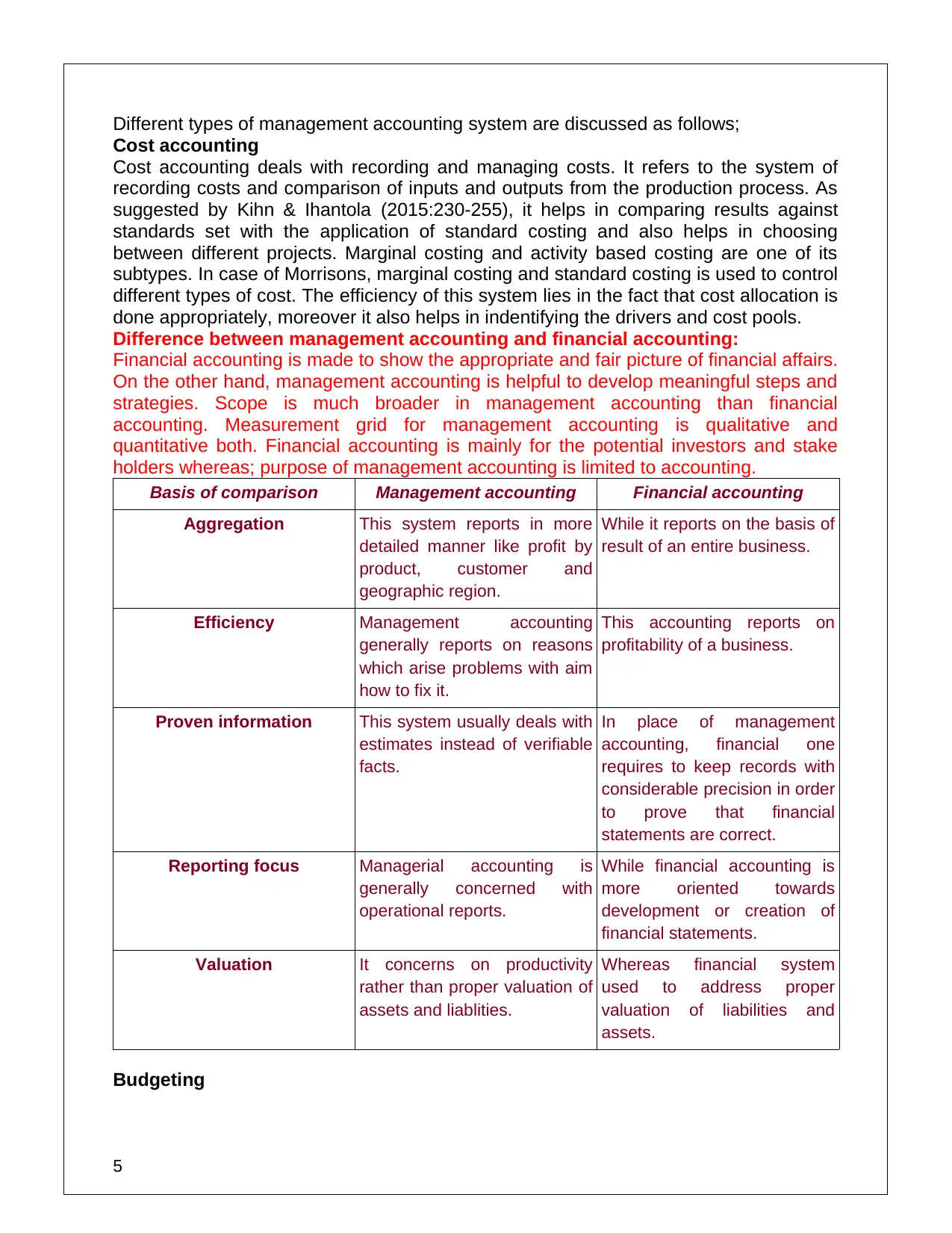
Different types of management accounting system are discussed as follows;
Cost accounting
Cost accounting deals with recording and managing costs. It refers to the system of
recording costs and comparison of inputs and outputs from the production process. As
suggested by Kihn & Ihantola (2015:230-255), it helps in comparing results against
standards set with the application of standard costing and also helps in choosing
between different projects. Marginal costing and activity based costing are one of its
subtypes. In case of Morrisons, marginal costing and standard costing is used to control
different types of cost. The efficiency of this system lies in the fact that cost allocation is
done appropriately, moreover it also helps in indentifying the drivers and cost pools.
Difference between management accounting and financial accounting:
Financial accounting is made to show the appropriate and fair picture of financial affairs.
On the other hand, management accounting is helpful to develop meaningful steps and
strategies. Scope is much broader in management accounting than financial
accounting. Measurement grid for management accounting is qualitative and
quantitative both. Financial accounting is mainly for the potential investors and stake
holders whereas; purpose of management accounting is limited to accounting.
Basis of comparison Management accounting Financial accounting
Aggregation This system reports in more
detailed manner like profit by
product, customer and
geographic region.
While it reports on the basis of
result of an entire business.
Efficiency Management accounting
generally reports on reasons
which arise problems with aim
how to fix it.
This accounting reports on
profitability of a business.
Proven information This system usually deals with
estimates instead of verifiable
facts.
In place of management
accounting, financial one
requires to keep records with
considerable precision in order
to prove that financial
statements are correct.
Reporting focus Managerial accounting is
generally concerned with
operational reports.
While financial accounting is
more oriented towards
development or creation of
financial statements.
Valuation It concerns on productivity
rather than proper valuation of
assets and liablities.
Whereas financial system
used to address proper
valuation of liabilities and
assets.
Budgeting
5
Cost accounting
Cost accounting deals with recording and managing costs. It refers to the system of
recording costs and comparison of inputs and outputs from the production process. As
suggested by Kihn & Ihantola (2015:230-255), it helps in comparing results against
standards set with the application of standard costing and also helps in choosing
between different projects. Marginal costing and activity based costing are one of its
subtypes. In case of Morrisons, marginal costing and standard costing is used to control
different types of cost. The efficiency of this system lies in the fact that cost allocation is
done appropriately, moreover it also helps in indentifying the drivers and cost pools.
Difference between management accounting and financial accounting:
Financial accounting is made to show the appropriate and fair picture of financial affairs.
On the other hand, management accounting is helpful to develop meaningful steps and
strategies. Scope is much broader in management accounting than financial
accounting. Measurement grid for management accounting is qualitative and
quantitative both. Financial accounting is mainly for the potential investors and stake
holders whereas; purpose of management accounting is limited to accounting.
Basis of comparison Management accounting Financial accounting
Aggregation This system reports in more
detailed manner like profit by
product, customer and
geographic region.
While it reports on the basis of
result of an entire business.
Efficiency Management accounting
generally reports on reasons
which arise problems with aim
how to fix it.
This accounting reports on
profitability of a business.
Proven information This system usually deals with
estimates instead of verifiable
facts.
In place of management
accounting, financial one
requires to keep records with
considerable precision in order
to prove that financial
statements are correct.
Reporting focus Managerial accounting is
generally concerned with
operational reports.
While financial accounting is
more oriented towards
development or creation of
financial statements.
Valuation It concerns on productivity
rather than proper valuation of
assets and liablities.
Whereas financial system
used to address proper
valuation of liabilities and
assets.
Budgeting
5
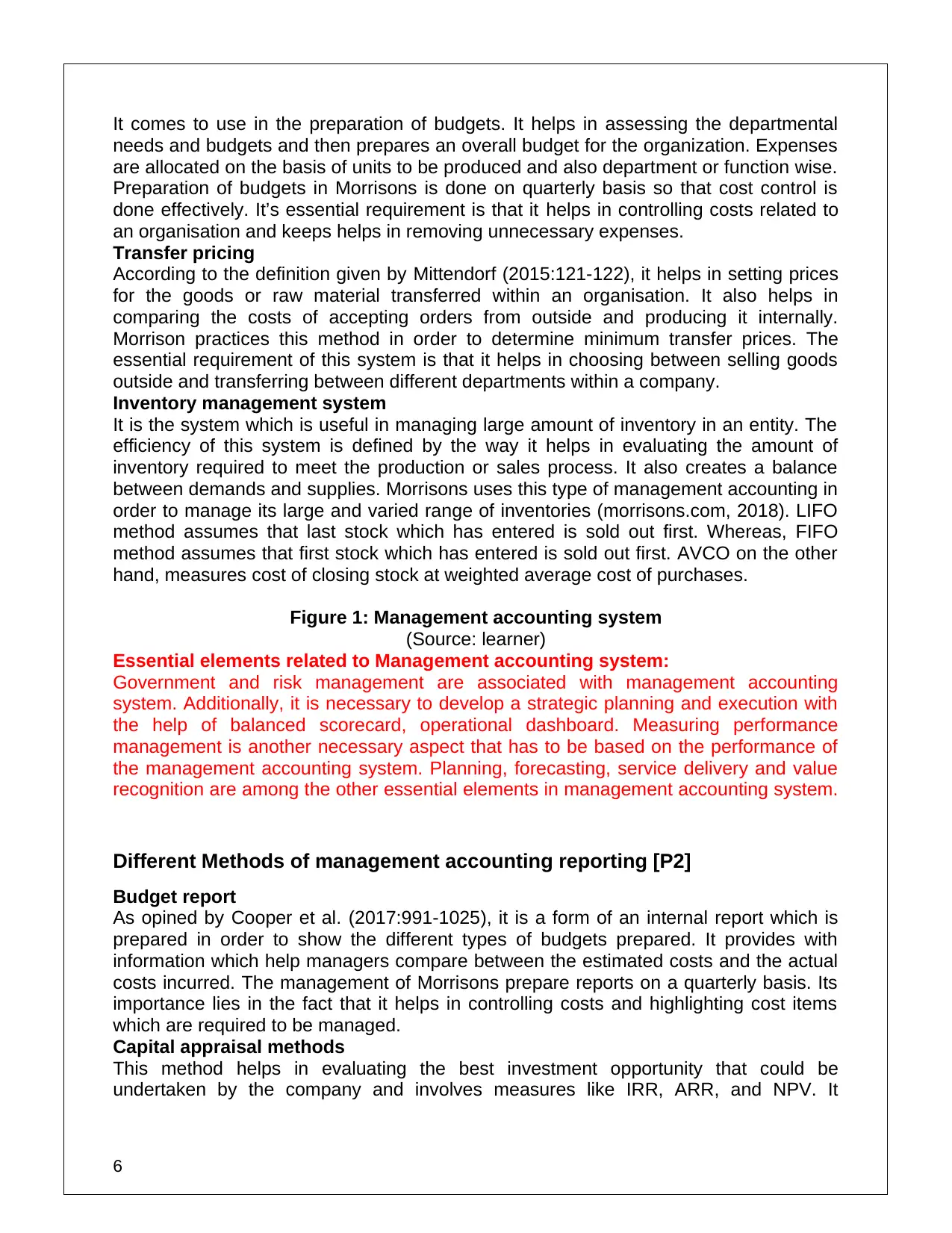
It comes to use in the preparation of budgets. It helps in assessing the departmental
needs and budgets and then prepares an overall budget for the organization. Expenses
are allocated on the basis of units to be produced and also department or function wise.
Preparation of budgets in Morrisons is done on quarterly basis so that cost control is
done effectively. It’s essential requirement is that it helps in controlling costs related to
an organisation and keeps helps in removing unnecessary expenses.
Transfer pricing
According to the definition given by Mittendorf (2015:121-122), it helps in setting prices
for the goods or raw material transferred within an organisation. It also helps in
comparing the costs of accepting orders from outside and producing it internally.
Morrison practices this method in order to determine minimum transfer prices. The
essential requirement of this system is that it helps in choosing between selling goods
outside and transferring between different departments within a company.
Inventory management system
It is the system which is useful in managing large amount of inventory in an entity. The
efficiency of this system is defined by the way it helps in evaluating the amount of
inventory required to meet the production or sales process. It also creates a balance
between demands and supplies. Morrisons uses this type of management accounting in
order to manage its large and varied range of inventories (morrisons.com, 2018). LIFO
method assumes that last stock which has entered is sold out first. Whereas, FIFO
method assumes that first stock which has entered is sold out first. AVCO on the other
hand, measures cost of closing stock at weighted average cost of purchases.
Figure 1: Management accounting system
(Source: learner)
Essential elements related to Management accounting system:
Government and risk management are associated with management accounting
system. Additionally, it is necessary to develop a strategic planning and execution with
the help of balanced scorecard, operational dashboard. Measuring performance
management is another necessary aspect that has to be based on the performance of
the management accounting system. Planning, forecasting, service delivery and value
recognition are among the other essential elements in management accounting system.
Different Methods of management accounting reporting [P2]
Budget report
As opined by Cooper et al. (2017:991-1025), it is a form of an internal report which is
prepared in order to show the different types of budgets prepared. It provides with
information which help managers compare between the estimated costs and the actual
costs incurred. The management of Morrisons prepare reports on a quarterly basis. Its
importance lies in the fact that it helps in controlling costs and highlighting cost items
which are required to be managed.
Capital appraisal methods
This method helps in evaluating the best investment opportunity that could be
undertaken by the company and involves measures like IRR, ARR, and NPV. It
6
needs and budgets and then prepares an overall budget for the organization. Expenses
are allocated on the basis of units to be produced and also department or function wise.
Preparation of budgets in Morrisons is done on quarterly basis so that cost control is
done effectively. It’s essential requirement is that it helps in controlling costs related to
an organisation and keeps helps in removing unnecessary expenses.
Transfer pricing
According to the definition given by Mittendorf (2015:121-122), it helps in setting prices
for the goods or raw material transferred within an organisation. It also helps in
comparing the costs of accepting orders from outside and producing it internally.
Morrison practices this method in order to determine minimum transfer prices. The
essential requirement of this system is that it helps in choosing between selling goods
outside and transferring between different departments within a company.
Inventory management system
It is the system which is useful in managing large amount of inventory in an entity. The
efficiency of this system is defined by the way it helps in evaluating the amount of
inventory required to meet the production or sales process. It also creates a balance
between demands and supplies. Morrisons uses this type of management accounting in
order to manage its large and varied range of inventories (morrisons.com, 2018). LIFO
method assumes that last stock which has entered is sold out first. Whereas, FIFO
method assumes that first stock which has entered is sold out first. AVCO on the other
hand, measures cost of closing stock at weighted average cost of purchases.
Figure 1: Management accounting system
(Source: learner)
Essential elements related to Management accounting system:
Government and risk management are associated with management accounting
system. Additionally, it is necessary to develop a strategic planning and execution with
the help of balanced scorecard, operational dashboard. Measuring performance
management is another necessary aspect that has to be based on the performance of
the management accounting system. Planning, forecasting, service delivery and value
recognition are among the other essential elements in management accounting system.
Different Methods of management accounting reporting [P2]
Budget report
As opined by Cooper et al. (2017:991-1025), it is a form of an internal report which is
prepared in order to show the different types of budgets prepared. It provides with
information which help managers compare between the estimated costs and the actual
costs incurred. The management of Morrisons prepare reports on a quarterly basis. Its
importance lies in the fact that it helps in controlling costs and highlighting cost items
which are required to be managed.
Capital appraisal methods
This method helps in evaluating the best investment opportunity that could be
undertaken by the company and involves measures like IRR, ARR, and NPV. It
6
⊘ This is a preview!⊘
Do you want full access?
Subscribe today to unlock all pages.

Trusted by 1+ million students worldwide
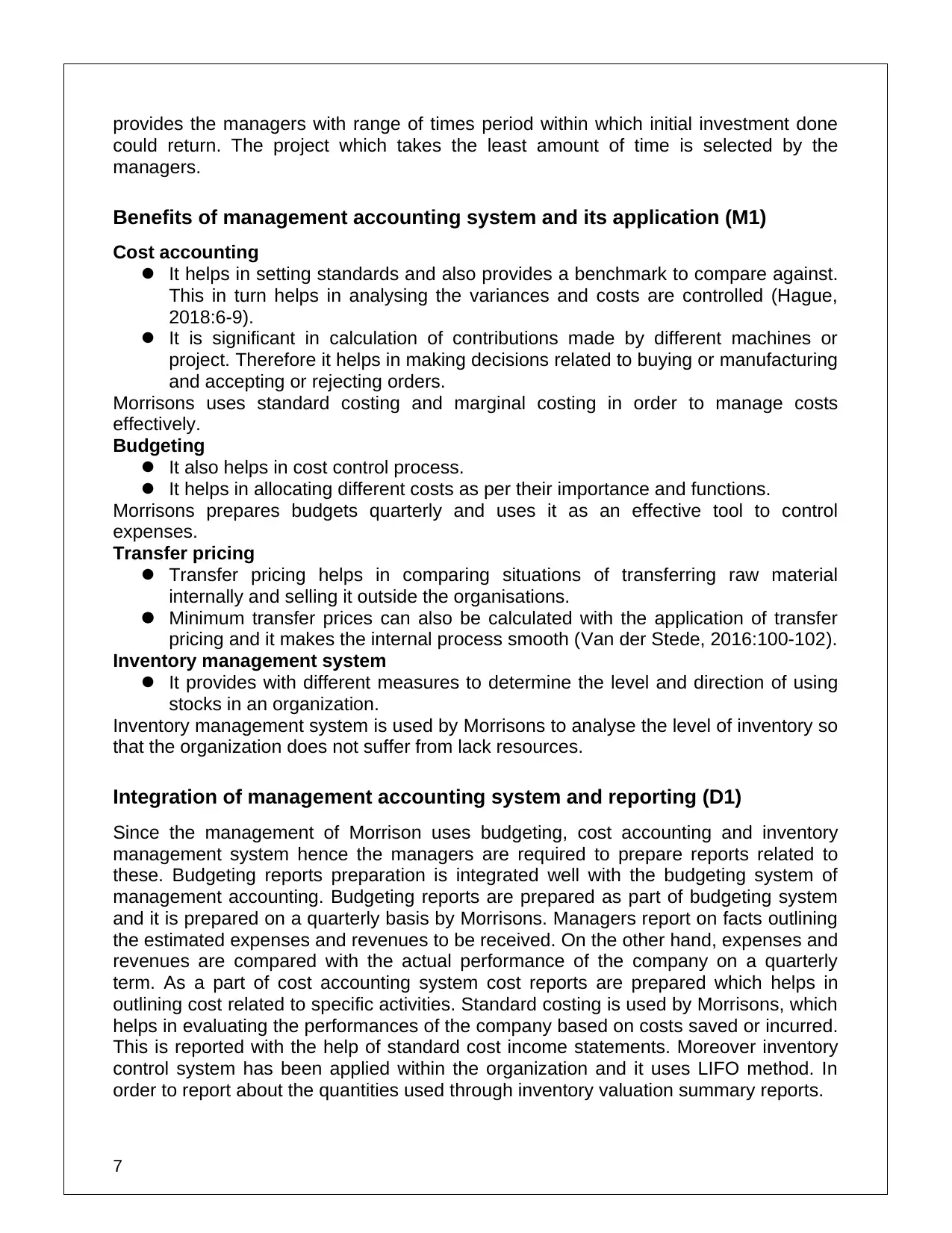
provides the managers with range of times period within which initial investment done
could return. The project which takes the least amount of time is selected by the
managers.
Benefits of management accounting system and its application (M1)
Cost accounting
It helps in setting standards and also provides a benchmark to compare against.
This in turn helps in analysing the variances and costs are controlled (Hague,
2018:6-9).
It is significant in calculation of contributions made by different machines or
project. Therefore it helps in making decisions related to buying or manufacturing
and accepting or rejecting orders.
Morrisons uses standard costing and marginal costing in order to manage costs
effectively.
Budgeting
It also helps in cost control process.
It helps in allocating different costs as per their importance and functions.
Morrisons prepares budgets quarterly and uses it as an effective tool to control
expenses.
Transfer pricing
Transfer pricing helps in comparing situations of transferring raw material
internally and selling it outside the organisations.
Minimum transfer prices can also be calculated with the application of transfer
pricing and it makes the internal process smooth (Van der Stede, 2016:100-102).
Inventory management system
It provides with different measures to determine the level and direction of using
stocks in an organization.
Inventory management system is used by Morrisons to analyse the level of inventory so
that the organization does not suffer from lack resources.
Integration of management accounting system and reporting (D1)
Since the management of Morrison uses budgeting, cost accounting and inventory
management system hence the managers are required to prepare reports related to
these. Budgeting reports preparation is integrated well with the budgeting system of
management accounting. Budgeting reports are prepared as part of budgeting system
and it is prepared on a quarterly basis by Morrisons. Managers report on facts outlining
the estimated expenses and revenues to be received. On the other hand, expenses and
revenues are compared with the actual performance of the company on a quarterly
term. As a part of cost accounting system cost reports are prepared which helps in
outlining cost related to specific activities. Standard costing is used by Morrisons, which
helps in evaluating the performances of the company based on costs saved or incurred.
This is reported with the help of standard cost income statements. Moreover inventory
control system has been applied within the organization and it uses LIFO method. In
order to report about the quantities used through inventory valuation summary reports.
7
could return. The project which takes the least amount of time is selected by the
managers.
Benefits of management accounting system and its application (M1)
Cost accounting
It helps in setting standards and also provides a benchmark to compare against.
This in turn helps in analysing the variances and costs are controlled (Hague,
2018:6-9).
It is significant in calculation of contributions made by different machines or
project. Therefore it helps in making decisions related to buying or manufacturing
and accepting or rejecting orders.
Morrisons uses standard costing and marginal costing in order to manage costs
effectively.
Budgeting
It also helps in cost control process.
It helps in allocating different costs as per their importance and functions.
Morrisons prepares budgets quarterly and uses it as an effective tool to control
expenses.
Transfer pricing
Transfer pricing helps in comparing situations of transferring raw material
internally and selling it outside the organisations.
Minimum transfer prices can also be calculated with the application of transfer
pricing and it makes the internal process smooth (Van der Stede, 2016:100-102).
Inventory management system
It provides with different measures to determine the level and direction of using
stocks in an organization.
Inventory management system is used by Morrisons to analyse the level of inventory so
that the organization does not suffer from lack resources.
Integration of management accounting system and reporting (D1)
Since the management of Morrison uses budgeting, cost accounting and inventory
management system hence the managers are required to prepare reports related to
these. Budgeting reports preparation is integrated well with the budgeting system of
management accounting. Budgeting reports are prepared as part of budgeting system
and it is prepared on a quarterly basis by Morrisons. Managers report on facts outlining
the estimated expenses and revenues to be received. On the other hand, expenses and
revenues are compared with the actual performance of the company on a quarterly
term. As a part of cost accounting system cost reports are prepared which helps in
outlining cost related to specific activities. Standard costing is used by Morrisons, which
helps in evaluating the performances of the company based on costs saved or incurred.
This is reported with the help of standard cost income statements. Moreover inventory
control system has been applied within the organization and it uses LIFO method. In
order to report about the quantities used through inventory valuation summary reports.
7
Paraphrase This Document
Need a fresh take? Get an instant paraphrase of this document with our AI Paraphraser
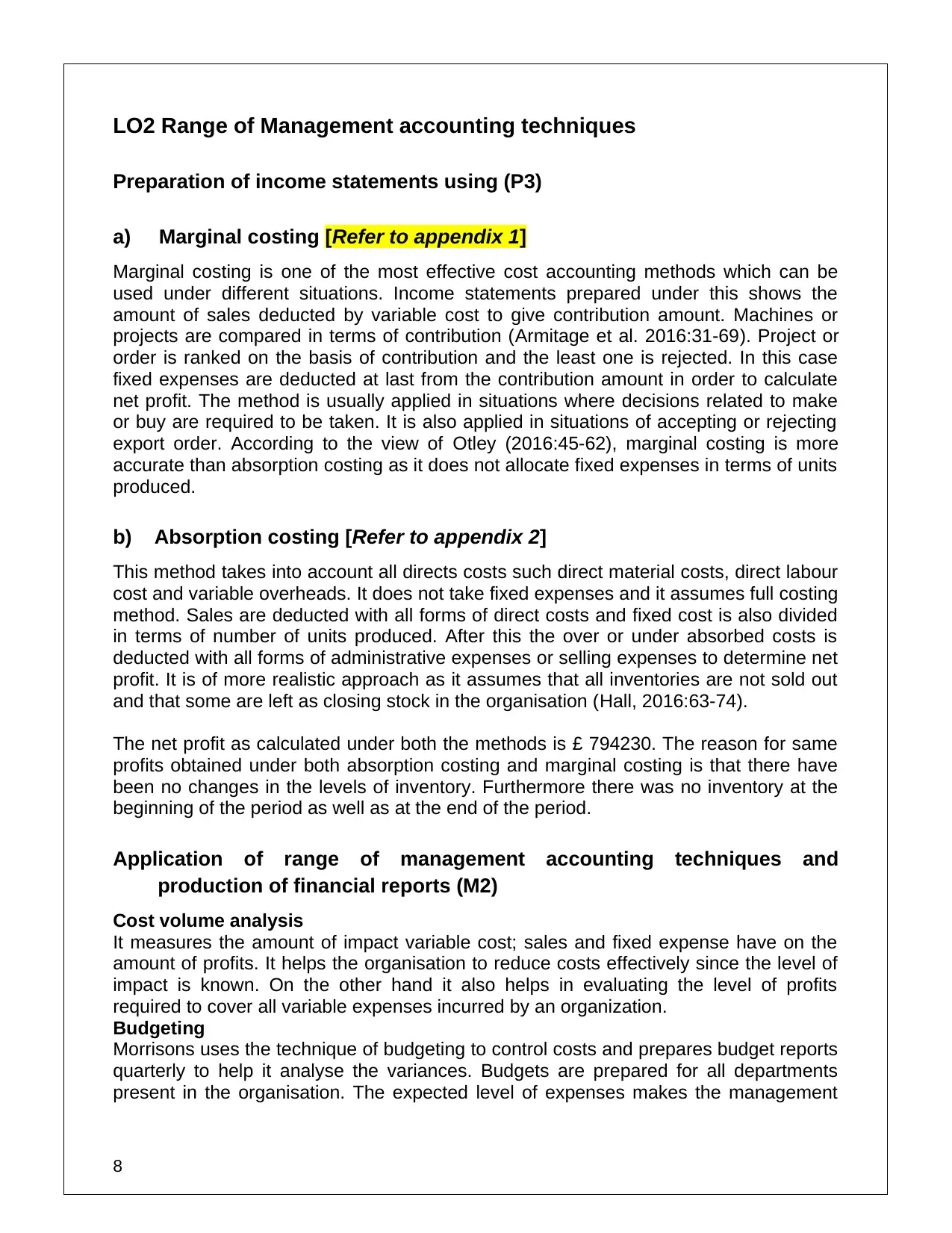
LO2 Range of Management accounting techniques
Preparation of income statements using (P3)
a) Marginal costing [Refer to appendix 1]
Marginal costing is one of the most effective cost accounting methods which can be
used under different situations. Income statements prepared under this shows the
amount of sales deducted by variable cost to give contribution amount. Machines or
projects are compared in terms of contribution (Armitage et al. 2016:31-69). Project or
order is ranked on the basis of contribution and the least one is rejected. In this case
fixed expenses are deducted at last from the contribution amount in order to calculate
net profit. The method is usually applied in situations where decisions related to make
or buy are required to be taken. It is also applied in situations of accepting or rejecting
export order. According to the view of Otley (2016:45-62), marginal costing is more
accurate than absorption costing as it does not allocate fixed expenses in terms of units
produced.
b) Absorption costing [Refer to appendix 2]
This method takes into account all directs costs such direct material costs, direct labour
cost and variable overheads. It does not take fixed expenses and it assumes full costing
method. Sales are deducted with all forms of direct costs and fixed cost is also divided
in terms of number of units produced. After this the over or under absorbed costs is
deducted with all forms of administrative expenses or selling expenses to determine net
profit. It is of more realistic approach as it assumes that all inventories are not sold out
and that some are left as closing stock in the organisation (Hall, 2016:63-74).
The net profit as calculated under both the methods is £ 794230. The reason for same
profits obtained under both absorption costing and marginal costing is that there have
been no changes in the levels of inventory. Furthermore there was no inventory at the
beginning of the period as well as at the end of the period.
Application of range of management accounting techniques and
production of financial reports (M2)
Cost volume analysis
It measures the amount of impact variable cost; sales and fixed expense have on the
amount of profits. It helps the organisation to reduce costs effectively since the level of
impact is known. On the other hand it also helps in evaluating the level of profits
required to cover all variable expenses incurred by an organization.
Budgeting
Morrisons uses the technique of budgeting to control costs and prepares budget reports
quarterly to help it analyse the variances. Budgets are prepared for all departments
present in the organisation. The expected level of expenses makes the management
8
Preparation of income statements using (P3)
a) Marginal costing [Refer to appendix 1]
Marginal costing is one of the most effective cost accounting methods which can be
used under different situations. Income statements prepared under this shows the
amount of sales deducted by variable cost to give contribution amount. Machines or
projects are compared in terms of contribution (Armitage et al. 2016:31-69). Project or
order is ranked on the basis of contribution and the least one is rejected. In this case
fixed expenses are deducted at last from the contribution amount in order to calculate
net profit. The method is usually applied in situations where decisions related to make
or buy are required to be taken. It is also applied in situations of accepting or rejecting
export order. According to the view of Otley (2016:45-62), marginal costing is more
accurate than absorption costing as it does not allocate fixed expenses in terms of units
produced.
b) Absorption costing [Refer to appendix 2]
This method takes into account all directs costs such direct material costs, direct labour
cost and variable overheads. It does not take fixed expenses and it assumes full costing
method. Sales are deducted with all forms of direct costs and fixed cost is also divided
in terms of number of units produced. After this the over or under absorbed costs is
deducted with all forms of administrative expenses or selling expenses to determine net
profit. It is of more realistic approach as it assumes that all inventories are not sold out
and that some are left as closing stock in the organisation (Hall, 2016:63-74).
The net profit as calculated under both the methods is £ 794230. The reason for same
profits obtained under both absorption costing and marginal costing is that there have
been no changes in the levels of inventory. Furthermore there was no inventory at the
beginning of the period as well as at the end of the period.
Application of range of management accounting techniques and
production of financial reports (M2)
Cost volume analysis
It measures the amount of impact variable cost; sales and fixed expense have on the
amount of profits. It helps the organisation to reduce costs effectively since the level of
impact is known. On the other hand it also helps in evaluating the level of profits
required to cover all variable expenses incurred by an organization.
Budgeting
Morrisons uses the technique of budgeting to control costs and prepares budget reports
quarterly to help it analyse the variances. Budgets are prepared for all departments
present in the organisation. The expected level of expenses makes the management
8
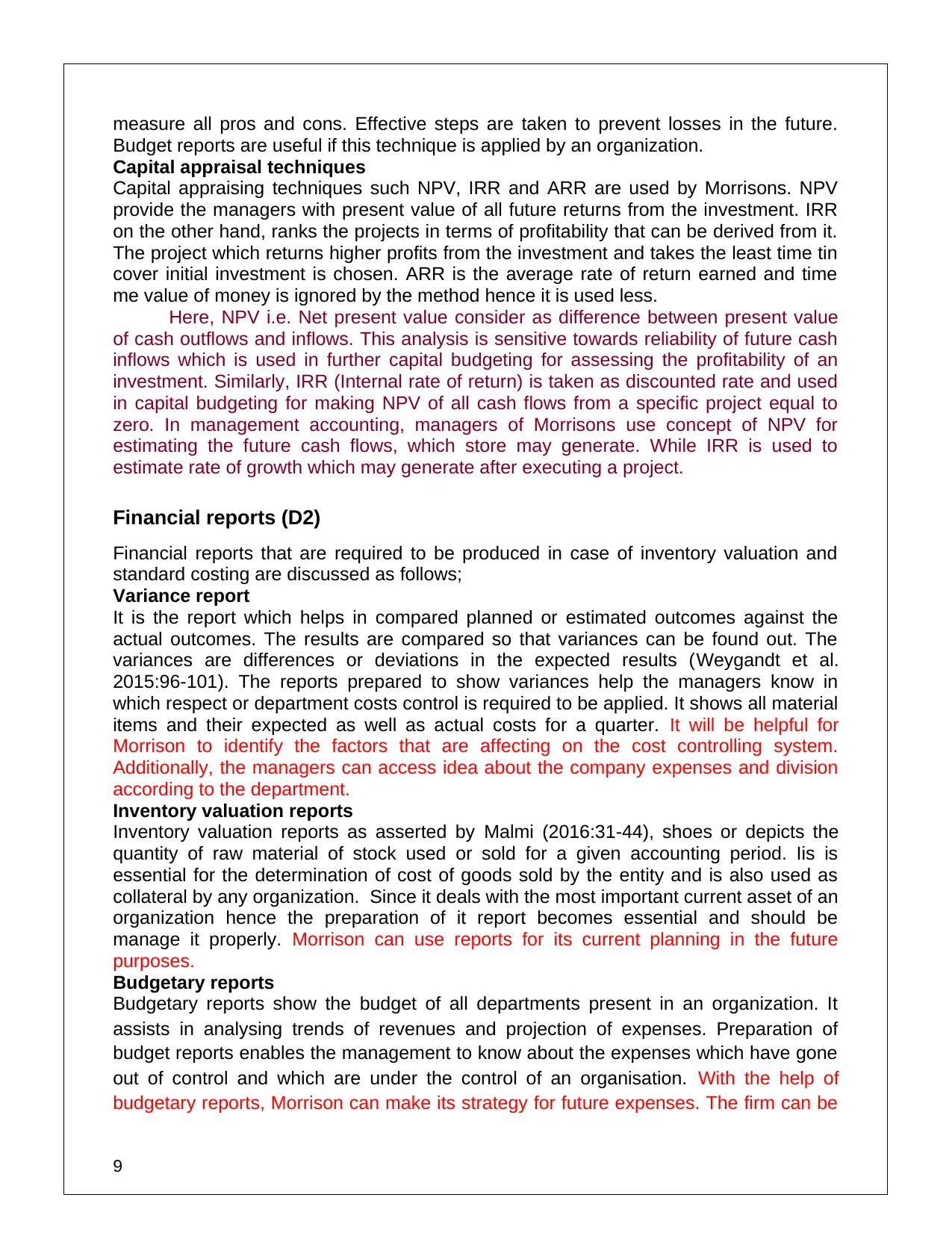
measure all pros and cons. Effective steps are taken to prevent losses in the future.
Budget reports are useful if this technique is applied by an organization.
Capital appraisal techniques
Capital appraising techniques such NPV, IRR and ARR are used by Morrisons. NPV
provide the managers with present value of all future returns from the investment. IRR
on the other hand, ranks the projects in terms of profitability that can be derived from it.
The project which returns higher profits from the investment and takes the least time tin
cover initial investment is chosen. ARR is the average rate of return earned and time
me value of money is ignored by the method hence it is used less.
Here, NPV i.e. Net present value consider as difference between present value
of cash outflows and inflows. This analysis is sensitive towards reliability of future cash
inflows which is used in further capital budgeting for assessing the profitability of an
investment. Similarly, IRR (Internal rate of return) is taken as discounted rate and used
in capital budgeting for making NPV of all cash flows from a specific project equal to
zero. In management accounting, managers of Morrisons use concept of NPV for
estimating the future cash flows, which store may generate. While IRR is used to
estimate rate of growth which may generate after executing a project.
Financial reports (D2)
Financial reports that are required to be produced in case of inventory valuation and
standard costing are discussed as follows;
Variance report
It is the report which helps in compared planned or estimated outcomes against the
actual outcomes. The results are compared so that variances can be found out. The
variances are differences or deviations in the expected results (Weygandt et al.
2015:96-101). The reports prepared to show variances help the managers know in
which respect or department costs control is required to be applied. It shows all material
items and their expected as well as actual costs for a quarter. It will be helpful for
Morrison to identify the factors that are affecting on the cost controlling system.
Additionally, the managers can access idea about the company expenses and division
according to the department.
Inventory valuation reports
Inventory valuation reports as asserted by Malmi (2016:31-44), shoes or depicts the
quantity of raw material of stock used or sold for a given accounting period. Iis is
essential for the determination of cost of goods sold by the entity and is also used as
collateral by any organization. Since it deals with the most important current asset of an
organization hence the preparation of it report becomes essential and should be
manage it properly. Morrison can use reports for its current planning in the future
purposes.
Budgetary reports
Budgetary reports show the budget of all departments present in an organization. It
assists in analysing trends of revenues and projection of expenses. Preparation of
budget reports enables the management to know about the expenses which have gone
out of control and which are under the control of an organisation. With the help of
budgetary reports, Morrison can make its strategy for future expenses. The firm can be
9
Budget reports are useful if this technique is applied by an organization.
Capital appraisal techniques
Capital appraising techniques such NPV, IRR and ARR are used by Morrisons. NPV
provide the managers with present value of all future returns from the investment. IRR
on the other hand, ranks the projects in terms of profitability that can be derived from it.
The project which returns higher profits from the investment and takes the least time tin
cover initial investment is chosen. ARR is the average rate of return earned and time
me value of money is ignored by the method hence it is used less.
Here, NPV i.e. Net present value consider as difference between present value
of cash outflows and inflows. This analysis is sensitive towards reliability of future cash
inflows which is used in further capital budgeting for assessing the profitability of an
investment. Similarly, IRR (Internal rate of return) is taken as discounted rate and used
in capital budgeting for making NPV of all cash flows from a specific project equal to
zero. In management accounting, managers of Morrisons use concept of NPV for
estimating the future cash flows, which store may generate. While IRR is used to
estimate rate of growth which may generate after executing a project.
Financial reports (D2)
Financial reports that are required to be produced in case of inventory valuation and
standard costing are discussed as follows;
Variance report
It is the report which helps in compared planned or estimated outcomes against the
actual outcomes. The results are compared so that variances can be found out. The
variances are differences or deviations in the expected results (Weygandt et al.
2015:96-101). The reports prepared to show variances help the managers know in
which respect or department costs control is required to be applied. It shows all material
items and their expected as well as actual costs for a quarter. It will be helpful for
Morrison to identify the factors that are affecting on the cost controlling system.
Additionally, the managers can access idea about the company expenses and division
according to the department.
Inventory valuation reports
Inventory valuation reports as asserted by Malmi (2016:31-44), shoes or depicts the
quantity of raw material of stock used or sold for a given accounting period. Iis is
essential for the determination of cost of goods sold by the entity and is also used as
collateral by any organization. Since it deals with the most important current asset of an
organization hence the preparation of it report becomes essential and should be
manage it properly. Morrison can use reports for its current planning in the future
purposes.
Budgetary reports
Budgetary reports show the budget of all departments present in an organization. It
assists in analysing trends of revenues and projection of expenses. Preparation of
budget reports enables the management to know about the expenses which have gone
out of control and which are under the control of an organisation. With the help of
budgetary reports, Morrison can make its strategy for future expenses. The firm can be
9
⊘ This is a preview!⊘
Do you want full access?
Subscribe today to unlock all pages.

Trusted by 1+ million students worldwide
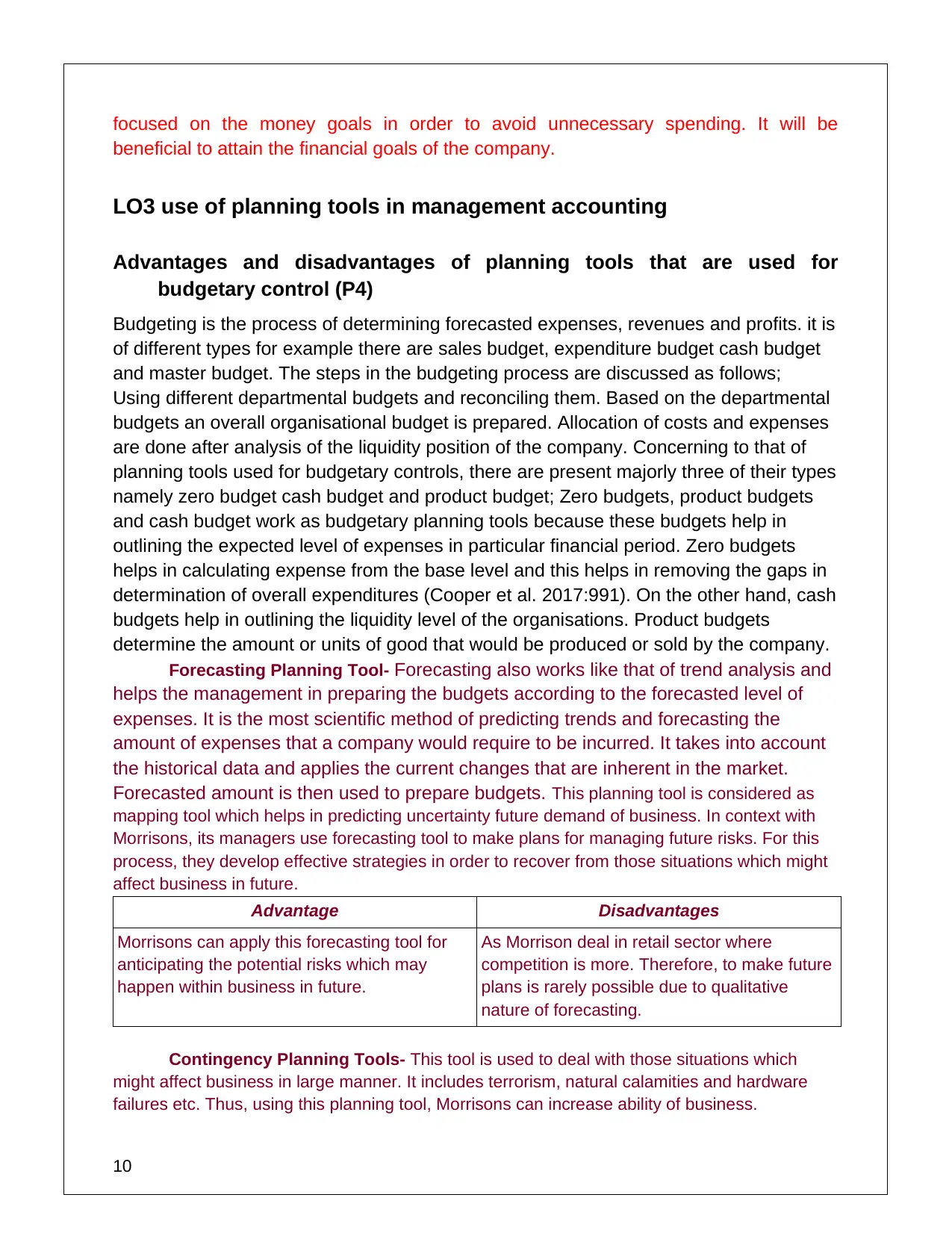
focused on the money goals in order to avoid unnecessary spending. It will be
beneficial to attain the financial goals of the company.
LO3 use of planning tools in management accounting
Advantages and disadvantages of planning tools that are used for
budgetary control (P4)
Budgeting is the process of determining forecasted expenses, revenues and profits. it is
of different types for example there are sales budget, expenditure budget cash budget
and master budget. The steps in the budgeting process are discussed as follows;
Using different departmental budgets and reconciling them. Based on the departmental
budgets an overall organisational budget is prepared. Allocation of costs and expenses
are done after analysis of the liquidity position of the company. Concerning to that of
planning tools used for budgetary controls, there are present majorly three of their types
namely zero budget cash budget and product budget; Zero budgets, product budgets
and cash budget work as budgetary planning tools because these budgets help in
outlining the expected level of expenses in particular financial period. Zero budgets
helps in calculating expense from the base level and this helps in removing the gaps in
determination of overall expenditures (Cooper et al. 2017:991). On the other hand, cash
budgets help in outlining the liquidity level of the organisations. Product budgets
determine the amount or units of good that would be produced or sold by the company.
Forecasting Planning Tool- Forecasting also works like that of trend analysis and
helps the management in preparing the budgets according to the forecasted level of
expenses. It is the most scientific method of predicting trends and forecasting the
amount of expenses that a company would require to be incurred. It takes into account
the historical data and applies the current changes that are inherent in the market.
Forecasted amount is then used to prepare budgets. This planning tool is considered as
mapping tool which helps in predicting uncertainty future demand of business. In context with
Morrisons, its managers use forecasting tool to make plans for managing future risks. For this
process, they develop effective strategies in order to recover from those situations which might
affect business in future.
Advantage Disadvantages
Morrisons can apply this forecasting tool for
anticipating the potential risks which may
happen within business in future.
As Morrison deal in retail sector where
competition is more. Therefore, to make future
plans is rarely possible due to qualitative
nature of forecasting.
Contingency Planning Tools- This tool is used to deal with those situations which
might affect business in large manner. It includes terrorism, natural calamities and hardware
failures etc. Thus, using this planning tool, Morrisons can increase ability of business.
10
beneficial to attain the financial goals of the company.
LO3 use of planning tools in management accounting
Advantages and disadvantages of planning tools that are used for
budgetary control (P4)
Budgeting is the process of determining forecasted expenses, revenues and profits. it is
of different types for example there are sales budget, expenditure budget cash budget
and master budget. The steps in the budgeting process are discussed as follows;
Using different departmental budgets and reconciling them. Based on the departmental
budgets an overall organisational budget is prepared. Allocation of costs and expenses
are done after analysis of the liquidity position of the company. Concerning to that of
planning tools used for budgetary controls, there are present majorly three of their types
namely zero budget cash budget and product budget; Zero budgets, product budgets
and cash budget work as budgetary planning tools because these budgets help in
outlining the expected level of expenses in particular financial period. Zero budgets
helps in calculating expense from the base level and this helps in removing the gaps in
determination of overall expenditures (Cooper et al. 2017:991). On the other hand, cash
budgets help in outlining the liquidity level of the organisations. Product budgets
determine the amount or units of good that would be produced or sold by the company.
Forecasting Planning Tool- Forecasting also works like that of trend analysis and
helps the management in preparing the budgets according to the forecasted level of
expenses. It is the most scientific method of predicting trends and forecasting the
amount of expenses that a company would require to be incurred. It takes into account
the historical data and applies the current changes that are inherent in the market.
Forecasted amount is then used to prepare budgets. This planning tool is considered as
mapping tool which helps in predicting uncertainty future demand of business. In context with
Morrisons, its managers use forecasting tool to make plans for managing future risks. For this
process, they develop effective strategies in order to recover from those situations which might
affect business in future.
Advantage Disadvantages
Morrisons can apply this forecasting tool for
anticipating the potential risks which may
happen within business in future.
As Morrison deal in retail sector where
competition is more. Therefore, to make future
plans is rarely possible due to qualitative
nature of forecasting.
Contingency Planning Tools- This tool is used to deal with those situations which
might affect business in large manner. It includes terrorism, natural calamities and hardware
failures etc. Thus, using this planning tool, Morrisons can increase ability of business.
10
Paraphrase This Document
Need a fresh take? Get an instant paraphrase of this document with our AI Paraphraser
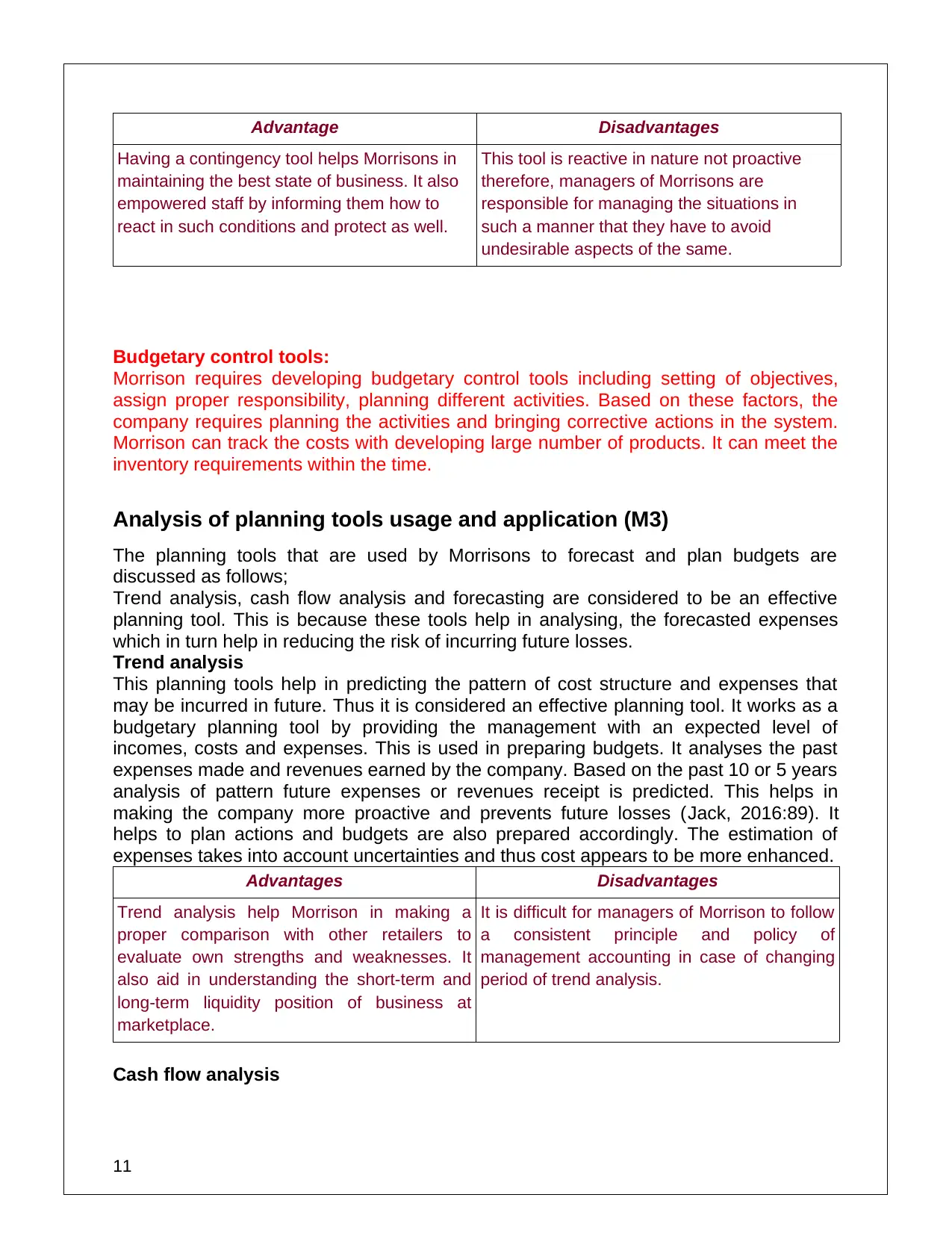
Advantage Disadvantages
Having a contingency tool helps Morrisons in
maintaining the best state of business. It also
empowered staff by informing them how to
react in such conditions and protect as well.
This tool is reactive in nature not proactive
therefore, managers of Morrisons are
responsible for managing the situations in
such a manner that they have to avoid
undesirable aspects of the same.
Budgetary control tools:
Morrison requires developing budgetary control tools including setting of objectives,
assign proper responsibility, planning different activities. Based on these factors, the
company requires planning the activities and bringing corrective actions in the system.
Morrison can track the costs with developing large number of products. It can meet the
inventory requirements within the time.
Analysis of planning tools usage and application (M3)
The planning tools that are used by Morrisons to forecast and plan budgets are
discussed as follows;
Trend analysis, cash flow analysis and forecasting are considered to be an effective
planning tool. This is because these tools help in analysing, the forecasted expenses
which in turn help in reducing the risk of incurring future losses.
Trend analysis
This planning tools help in predicting the pattern of cost structure and expenses that
may be incurred in future. Thus it is considered an effective planning tool. It works as a
budgetary planning tool by providing the management with an expected level of
incomes, costs and expenses. This is used in preparing budgets. It analyses the past
expenses made and revenues earned by the company. Based on the past 10 or 5 years
analysis of pattern future expenses or revenues receipt is predicted. This helps in
making the company more proactive and prevents future losses (Jack, 2016:89). It
helps to plan actions and budgets are also prepared accordingly. The estimation of
expenses takes into account uncertainties and thus cost appears to be more enhanced.
Advantages Disadvantages
Trend analysis help Morrison in making a
proper comparison with other retailers to
evaluate own strengths and weaknesses. It
also aid in understanding the short-term and
long-term liquidity position of business at
marketplace.
It is difficult for managers of Morrison to follow
a consistent principle and policy of
management accounting in case of changing
period of trend analysis.
Cash flow analysis
11
Having a contingency tool helps Morrisons in
maintaining the best state of business. It also
empowered staff by informing them how to
react in such conditions and protect as well.
This tool is reactive in nature not proactive
therefore, managers of Morrisons are
responsible for managing the situations in
such a manner that they have to avoid
undesirable aspects of the same.
Budgetary control tools:
Morrison requires developing budgetary control tools including setting of objectives,
assign proper responsibility, planning different activities. Based on these factors, the
company requires planning the activities and bringing corrective actions in the system.
Morrison can track the costs with developing large number of products. It can meet the
inventory requirements within the time.
Analysis of planning tools usage and application (M3)
The planning tools that are used by Morrisons to forecast and plan budgets are
discussed as follows;
Trend analysis, cash flow analysis and forecasting are considered to be an effective
planning tool. This is because these tools help in analysing, the forecasted expenses
which in turn help in reducing the risk of incurring future losses.
Trend analysis
This planning tools help in predicting the pattern of cost structure and expenses that
may be incurred in future. Thus it is considered an effective planning tool. It works as a
budgetary planning tool by providing the management with an expected level of
incomes, costs and expenses. This is used in preparing budgets. It analyses the past
expenses made and revenues earned by the company. Based on the past 10 or 5 years
analysis of pattern future expenses or revenues receipt is predicted. This helps in
making the company more proactive and prevents future losses (Jack, 2016:89). It
helps to plan actions and budgets are also prepared accordingly. The estimation of
expenses takes into account uncertainties and thus cost appears to be more enhanced.
Advantages Disadvantages
Trend analysis help Morrison in making a
proper comparison with other retailers to
evaluate own strengths and weaknesses. It
also aid in understanding the short-term and
long-term liquidity position of business at
marketplace.
It is difficult for managers of Morrison to follow
a consistent principle and policy of
management accounting in case of changing
period of trend analysis.
Cash flow analysis
11
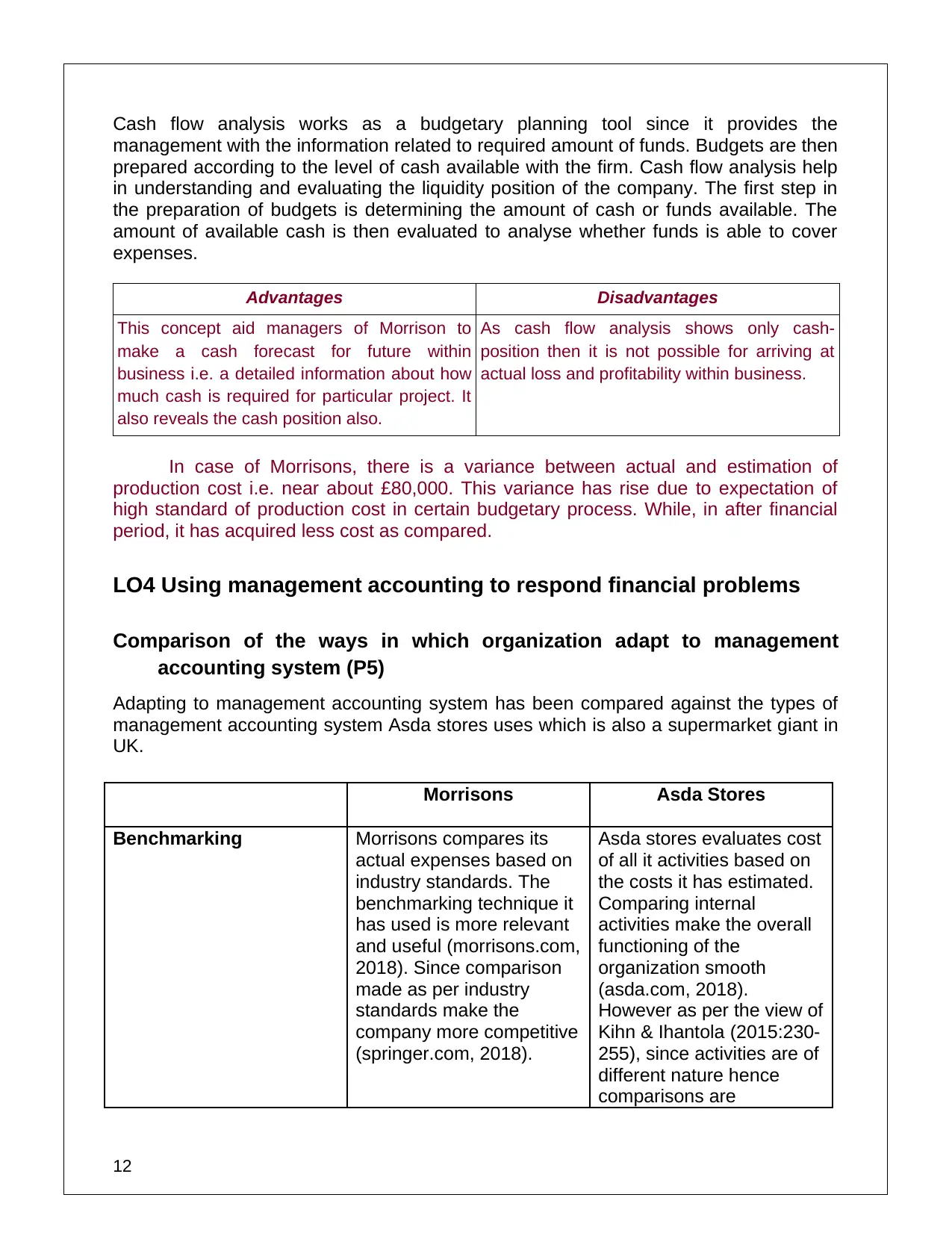
Cash flow analysis works as a budgetary planning tool since it provides the
management with the information related to required amount of funds. Budgets are then
prepared according to the level of cash available with the firm. Cash flow analysis help
in understanding and evaluating the liquidity position of the company. The first step in
the preparation of budgets is determining the amount of cash or funds available. The
amount of available cash is then evaluated to analyse whether funds is able to cover
expenses.
Advantages Disadvantages
This concept aid managers of Morrison to
make a cash forecast for future within
business i.e. a detailed information about how
much cash is required for particular project. It
also reveals the cash position also.
As cash flow analysis shows only cash-
position then it is not possible for arriving at
actual loss and profitability within business.
In case of Morrisons, there is a variance between actual and estimation of
production cost i.e. near about £80,000. This variance has rise due to expectation of
high standard of production cost in certain budgetary process. While, in after financial
period, it has acquired less cost as compared.
LO4 Using management accounting to respond financial problems
Comparison of the ways in which organization adapt to management
accounting system (P5)
Adapting to management accounting system has been compared against the types of
management accounting system Asda stores uses which is also a supermarket giant in
UK.
Morrisons Asda Stores
Benchmarking Morrisons compares its
actual expenses based on
industry standards. The
benchmarking technique it
has used is more relevant
and useful (morrisons.com,
2018). Since comparison
made as per industry
standards make the
company more competitive
(springer.com, 2018).
Asda stores evaluates cost
of all it activities based on
the costs it has estimated.
Comparing internal
activities make the overall
functioning of the
organization smooth
(asda.com, 2018).
However as per the view of
Kihn & Ihantola (2015:230-
255), since activities are of
different nature hence
comparisons are
12
management with the information related to required amount of funds. Budgets are then
prepared according to the level of cash available with the firm. Cash flow analysis help
in understanding and evaluating the liquidity position of the company. The first step in
the preparation of budgets is determining the amount of cash or funds available. The
amount of available cash is then evaluated to analyse whether funds is able to cover
expenses.
Advantages Disadvantages
This concept aid managers of Morrison to
make a cash forecast for future within
business i.e. a detailed information about how
much cash is required for particular project. It
also reveals the cash position also.
As cash flow analysis shows only cash-
position then it is not possible for arriving at
actual loss and profitability within business.
In case of Morrisons, there is a variance between actual and estimation of
production cost i.e. near about £80,000. This variance has rise due to expectation of
high standard of production cost in certain budgetary process. While, in after financial
period, it has acquired less cost as compared.
LO4 Using management accounting to respond financial problems
Comparison of the ways in which organization adapt to management
accounting system (P5)
Adapting to management accounting system has been compared against the types of
management accounting system Asda stores uses which is also a supermarket giant in
UK.
Morrisons Asda Stores
Benchmarking Morrisons compares its
actual expenses based on
industry standards. The
benchmarking technique it
has used is more relevant
and useful (morrisons.com,
2018). Since comparison
made as per industry
standards make the
company more competitive
(springer.com, 2018).
Asda stores evaluates cost
of all it activities based on
the costs it has estimated.
Comparing internal
activities make the overall
functioning of the
organization smooth
(asda.com, 2018).
However as per the view of
Kihn & Ihantola (2015:230-
255), since activities are of
different nature hence
comparisons are
12
⊘ This is a preview!⊘
Do you want full access?
Subscribe today to unlock all pages.

Trusted by 1+ million students worldwide
1 out of 18
Related Documents
Your All-in-One AI-Powered Toolkit for Academic Success.
+13062052269
info@desklib.com
Available 24*7 on WhatsApp / Email
![[object Object]](/_next/static/media/star-bottom.7253800d.svg)
Unlock your academic potential
Copyright © 2020–2025 A2Z Services. All Rights Reserved. Developed and managed by ZUCOL.

